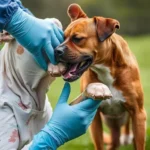
Understanding dog health care is crucial for all pet owners. Knowing when to take your dog to the emergency vet can be the difference between life and death. Emergencies can arise at any time, and being prepared will help ensure your furry friend receives the care they need promptly.
Statistics show that approximately 1 in 10 dogs will require emergency veterinary care at some point in their lives. Common emergencies include gastrointestinal issues, trauma, and respiratory problems. This article will guide you through recognizing the signs of a medical emergency, common emergencies, and how to take the right steps when your dog is in distress.
Understanding Dog Health Basics
Common Health Issues in Dogs
Dogs can suffer from a variety of health problems, some of which may lead to emergencies. Common issues include:
- Allergies: Many dogs experience allergies, which can lead to skin infections if not treated.
- Obesity: Overweight dogs are at risk for several health issues, including diabetes and joint problems.
- Dental Issues: Periodontal disease is prevalent in dogs and can lead to serious health complications.
Regular veterinary check-ups are essential in catching these issues early and preventing emergencies. A veterinarian can provide necessary vaccinations, dental care, and advice on proper diet and exercise.
Routine Preventive Care
Preventive care is key to a healthy dog. Vaccinations protect against diseases such as rabies and parvovirus, while regular grooming can prevent skin problems and matting. Dental hygiene is also vital; brushing your dog’s teeth can prevent periodontal disease and other health issues.
Recognizing Signs of a Medical Emergency
Behavioral Changes
Dogs are creatures of habit, and sudden changes in behavior can indicate distress. Look for signs such as:
- Unusual Aggression or Withdrawal: A normally friendly dog may become aggressive or hide if in pain.
- Loss of Appetite: A sudden refusal to eat or drink can signal a serious problem.
Understanding your dog’s normal behavior is essential in recognizing when something is wrong.
Physical Symptoms
Physical signs of distress that require immediate attention include:
- Vomiting and Diarrhea: Occasional vomiting may not be alarming, but persistent vomiting or diarrhea can lead to dehydration.
- Bleeding: Any form of bleeding, whether from a cut or internal bleeding, should be treated as an emergency.
Additionally, symptoms of heatstroke (panting, rapid heart rate, lethargy) and poisoning (drooling, tremors, or seizures) are critical signs that require urgent care.
Specific Situations
Certain situations can also signify an emergency:
- Injuries: Lacerations, bites, and fractures need immediate assessment.
- Unconsciousness or Seizures: If your dog loses consciousness or experiences seizures, act quickly to get them medical attention.
Common Dog Emergencies
Gastrointestinal Emergencies
Gastrointestinal issues can escalate quickly. Two critical conditions to be aware of are:
- Bloat (Gastric Torsion): Symptoms include a distended abdomen, restlessness, and unproductive vomiting. This is a life-threatening condition that requires immediate attention.
- Poisoning: Many household items, such as chocolate, grapes, and certain plants, are toxic to dogs. If you suspect poisoning, contact your vet immediately.
Respiratory Emergencies
Respiratory issues can be alarming. Be vigilant for:
- Difficulty Breathing: Signs include labored breathing, wheezing, or blue-tinged gums. These symptoms indicate that immediate veterinary care is necessary.
- Choking: If your dog is coughing violently or pawing at their mouth, they could be choking. Act quickly to dislodge the object or seek immediate help.
Cardiovascular Emergencies
Heart issues can be particularly dangerous. Look for:
- Signs of Heart Disease: Coughing, lethargy, and difficulty exercising can all be symptoms of heart problems.
- Shock Symptoms: Weakness, rapid heart rate, and pale gums may indicate shock and require immediate veterinary attention.
Trauma-Related Emergencies
Trauma can happen unexpectedly. Common scenarios include:
- Car Accidents: Dogs can suffer serious injuries in car accidents, even if they seem fine. Always have them checked after an accident.
- Injuries from Falls: Dogs can injure themselves by falling or jumping from heights. Look for swelling or limping to assess the severity.
To prevent these emergencies, ensure your dog is safely restrained during travel.
When to Take Your Dog to the Emergency Vet
Immediate Action Required
Certain signs indicate that you must take your dog to the emergency vet without delay. These include:
- Severe Bleeding: Apply pressure, but do not wait if the bleeding doesn’t stop quickly.
- Difficulty Breathing: This is always urgent; do not wait for the situation to worsen.
- Repeated Vomiting or Diarrhea: If your dog is unable to keep water down or exhibits both symptoms, it’s crucial to act fast.
First Aid Tips Before Heading to the Vet
If you find yourself in an emergency situation, here are some basic first aid tips:
- Apply Pressure to Wounds: Use a clean cloth to apply pressure to any bleeding wounds.
- Keep Your Dog Calm: Try to keep your dog as calm and still as possible while transporting them.
- Bring Important Items: Take along your dog’s medical records, if available, and any medications they are currently taking.
Evaluating the Situation
Not every situation requires immediate veterinary care. Assess the severity of your dog’s condition before deciding:
- Monitor Symptoms: If your dog shows mild symptoms but seems stable, consider waiting a few hours while observing their condition.
- Research Symptoms: Understanding what specific symptoms indicate can help you determine whether it’s an emergency.
Choosing the Right Emergency Vet
What to Look for in an Emergency Vet
When selecting an emergency vet, consider the following:
- Qualifications and Certifications: Ensure the facility has accredited veterinarians and staff trained in emergency care.
- Location and Availability: Choose a vet that is conveniently located and offers 24/7 services, as emergencies can happen at any time.
Preparing for the Visit
Being prepared can streamline your visit to the emergency vet. Bring:
- Medical History: A record of vaccinations, past illnesses, and any ongoing treatments.
- List of Symptoms: Detail what you’ve observed to help the vet assess the situation quickly.
Don’t hesitate to ask the vet questions during your visit, such as treatment options and follow-up care.
Post-Emergency Care
Follow-Up Care
After an emergency visit, follow-up care is critical. Your vet may recommend:
- Follow-Up Appointments: These are vital for monitoring recovery and addressing any ongoing issues.
- Recovery Protocols: Pay close attention to your vet’s instructions regarding medication, diet, and activity levels.
Preventing Future Emergencies
To help prevent emergencies in the future, consider the following tips:
- Regular Health Check-Ups: Routine veterinary visits can catch potential health issues before they become emergencies.
- Ongoing Education: Keep yourself informed about dog health care and emergency procedures.
Educating yourself will empower you to act quickly and confidently when your dog needs help.
Conclusion
Recognizing when to take your dog to the emergency vet is essential for every dog owner. Understanding the signs of distress and knowing the common emergencies can help ensure your dog receives timely care. By being proactive about your dog’s health and maintaining regular veterinary visits, you can significantly reduce the risk of emergencies.
Being prepared and informed not only helps keep your dog healthy but also strengthens the bond between you and your furry companion. If you have any concerns about your dog’s health, don’t hesitate to reach out to your veterinarian. Your dog relies on you for their well-being, and being vigilant about their health is a crucial part of responsible pet ownership.









